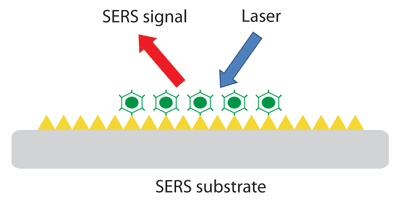Recovering native chemical information from surface-enhanced Raman scattering
For centuries, metals were employed in optical applications only as mirrors and gratings. New vistas opened up in the late 1970s and early 1980s with the discovery of surface-enhanced Raman scattering and the use of surface plasmon (collective electronic oscillations at the surface of metals) resonances for sensing. However, it was not until the 1990s, with the appearance of accurate and reliable nanofabrication techniques, that plasmonics blossomed.
Initially, the attention focused on the exploitation of surface plasmons for sensing, subwavelength waveguiding and extraordinary optical transmission. Since then, the scientific and technological interest in surface plasmons has expanded.
The Raman effect is a type of scattering of electromagnetic radiation in which light suffers a change in frequency and a change in phase as it passes through a material medium. Because of the low intensity of the effect, it was not till the development of the laser that the effect was put to use. In Raman spectroscopy light from a laser is passed through a substance and the scattering is analysed spectroscopically. The new frequencies in the Raman spectrum of monochromatic light scattered by a substance are characteristic of the substance. Hence, the technique is used as a means of determining molecular structure and as a tool in chemical analysis.

Localized surface plasmon resonances in metallic nanostructures can confine incident light into a nanoscale volume characterized by stronger optical fields. These hot-spots can dramatically enhance the Raman scattering leading to a so-called surface-enhanced Raman scattering (SERS) and spectroscopy. But there is a problem.
It was frequently observed that the relative intensity of different Raman peaks may vary from spot to spot even on the same surface, which is unexpected from the chemical interaction point of view because the chemical properties should remain similar. Importantly, localized surface plasmon resonances do not only provide a large electromagnetic enhancement but also induce strong modifications of the relative strength of the peaks in the SERS spectra. The latter effect can be seen as a plasmonic spectral shaping effect (PSSE). The distorted spectral features as a result of the PSSE can severely undermine the interpretation of the experimental data when extracting chemical information like molecular orientation, the charge transfer mechanism in plasmon-mediated photocatalysis, local chemical properties and so forth.
No robust and systematic procedure has been broadly adopted by the SERS community to treat the PSSE with generality. As a result, information from ‘untreated’ Raman spectra is still constantly used as the basis to reach incorrect conclusions regarding selection rules in vibrational spectroscopy, a situation detrimental for further developments of SERS, and even of other fields related to plasmon-enhanced chemical reactivity or two-dimensional materials spectroscopy. Thus, it is important to develop a general method to correct for the PSSE that is robust and universally adoptable.
Now, a team of researchers that includes DIPC’s Javier Aizpurua and Ruben Esteban, has developed 1 a method based on plasmonic photoluminescence for recovering native chemical information from surface-enhanced Raman scattering that meet these criteria.
The reasoning that supports the method is as follows. The photoluminescence of metal nanostructures is connected to the behaviour of the near fields inside the nanoparticle and considered to contribute to the broad ‘continuum’ background in a typical SERS spectra.

This background is commonly neglected or just directly subtracted to obtain a clean SERS spectrum, but its origin as photoluminiscence means that it should contain similar near field information as the PSSE. Therefore, the SERS background may potentially be used to correct the PSSE and to recover the intrinsic chemical information contained in the relative strength of the Raman peaks.
In order to to demonstrate such concept of correction, the researchers use single-gold nanorods as nanoantennas, which are resonant at different wavelengths but show the same chemical properties,. They carefully correlate their morphology, LSPR scattering, photoluminescence, SERS background and relative intensity of the SERS peaks (Figure 2).
Then they identify the contribution from the material response and the plasmonic enhancement to the photoluminescence by measuring the scattering and the photoluminescence response of the individual nanorods. Further quantitatively connection between the photoluminescence and SERS background is achieved by measuring the photoluminescence and SERS of single nanorods before and after the adsorption of molecules.
Based on these results, they propose a robust method to correct the PSSE that consists in normalizing the SERS by the SERS background. The researchers successfully apply this approach to resolve and understand the PSSE signal in nanorods system, and corroborate the results by analytical models and numerical simulations. The generality of the proposed method is further supported by the results from more complex plasmonic systems including gap-mode tip-enhanced Raman spectroscopy configurations and silver nanoaggregates.
A general protocol to correct the PSSE as this one could be very useful in analytical sciences, and opens a new path towards unambiguous retrieval of native chemical information from the relatively complex and distorted information of Raman peaks in surface-enhanced and tip-enhanced Raman spectroscopies spectra.
Author: César Tomé López is a science writer and the editor of Mapping Ignorance.
References
- Kai-Qiang Lin, Jun Yi, Jin-Hui Zhong, Shu Hu, Bi-Ju Liu, Jun-Yang Liu, Cheng Zong, Zhi-Chao Lei, Xiang Wang, Javier Aizpurua, Rubén Esteban & Bin Ren (2017) Plasmonic photoluminescence for recovering native chemical information from surface-enhanced Raman scattering Nature Communications doi: 10.1038/ncomms14891 ↩